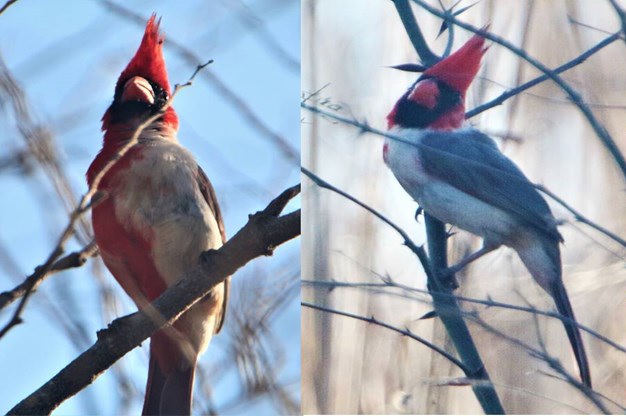Un caso de ginandromorfía en el Cardenal Norteño (Cardinalis cardinalis) en México, con una revisión de otros casos en Norteamérica
DOI:
https://doi.org/10.59517/oc.e544Keywords:
Cardinalidae, bilateral gynandromorphis, birds gynandromorphis, hermaphrodite, intersex, leucism, plumage, chimerismAbstract
Gynandromorphism is a phenomenon of an organism that possesses both male and female tissues and features that are unusual in nature, and rarely occurs in birds. During April 2020, we observed a possible bilateral Northern Cardinal (Cardinalis cardinalis) gynandromorph, in Mexico’s west coast, representing the first report of this kind for the whole country. Comparing to the historic reports of gynandromorphism in C. cardinalis, we noted that the plumage coloration on bilateral distribution excludes a bodily pattern and in some cases is incomplete. The causality of gynandromorphism is a genetic-phenotypic issue not yet well understood that still needs to be clarified through research in this especially interesting line; incidence records contribute to understanding behavior and areas of incidence, while future studies at the genomic level will be able to resolve and clarify this abnormality.
Downloads
References
Blanchard, R. & H. Descimon. 1988. Hybridization between two species of swallowtails, meiosis mechanism, and the genesis of gynandromorphs. Journal of the Lepidopterists' Society 42:94–102. https:// www.researchgate.net/publication/235556766
Bohlen, H. D. 2006. Illinois sightings of bilateral gynandromorphism in birds. The Living Museum 68: 15–id/5397
Clinton, M., D. Zhao, S. Nandi & D. Mcbride. 2012. Evidence for avian cell autonomous sex identity (CASI) and implications for the sex-determination process? Chromosome Research 20: 177–190. https://doi.org/10.1007/s10577-011-9257-9
Dacosta, J. M., G. M. Spellman & J. Klicka. 2007. Bilateral gynandromorphy in a White-ruffed Manakin (Corapipo altera). The Wilson Journal of Ornithology 119: 289–291. https://doi.org/10.1676/06-093.1
Graves, G., R. 1996. Comments on a probable gynandromorphic Black-Throated Blue Warbler. Wilson Bulletin 108: 178–180. https://www.jstor.org/ stable/4163654
Jones, A., W. & H. T. Bartlett. 2017. A bilateral gynandromorph Northern Cardinal from South Bass Island. Ohio Biological Survey Notes 7: 14–16. http://www.ohiobiologicalsurvey.org/wp-content/themes/ohio/images/Jones_Bartlett_2017.pdf
Kumerloeve, H. 1954. On gynandromorphism in birds. Emu 54: 71–72. https://doi.org/10.1071/MU954067g
Kumerloeve, H. 1987. Le gynandromorphisme chez les oiseaux–recapitulation des données connues. Alauda 55: 1–9. https://eurekamag.com/research/024/938/024938806.php
Laskey, A., R. 1969. Bilateral gynandrism in a Cardinal and a Rufous-sided Towhee. Auk 86: 760. https://doi.org/10.2307/4083473
Mahabal, A., H. Van Grouw, R. M. Sharma & S. Thakur. 2016. How common is albinism really? Colour aberrations in Indian birds reviewed. Dutch Birding 38: 301–309. https://nhm.openrepository.com/bitstream/handle/10141/622245/Grouw+DB38(2016)_Albinism+Indian+Birds.pdf?sequence=1
Major, A. T. & C. A. Smith. 2016. Sex reversal in birds. Sexual Development 10: 288–300. https://doi.org/10.1159/000448365
Patten, M. A. 1993. A probable bilateral gynandromorphic Black-throated Blue Warbler. Wilson Bulletin 105: 695– 698. https://www.jstor.org/stable/4163365
Peer, B., D. & R. W. Motz. 2014. Observations of a bilateral gynandromorph Northern Cardinal (Cardinalis cardinalis). The Wilson Journal of Ornithology 126: 778– 781. https://doi.org/10.1676/14-025.1
Rodríguez-Ruiz, E. R., W. A. Poot-Poot, R. Ruíz-Salazar & J. Treviño-Carreón J. 2017. Nuevos registros de aves con anormalidad pigmentaria en México y propuesta de clave dicotómica para la identificación de casos. El Huitzil 18: 57–70. http://www.scielo.org.mx/scielo.php?script=sci_arttext&pid=S1870-74592017000100057
Sibley, D. A. 2014. The Sibley Guide to Birds, 2nd Edition. Knopf (ed.), EE.UU. (bajado de https://www.sibleyguides.com/2011/08/abnormal-coloration-in-birds-melanin-reduction/ el 6 Septiembre 2022).
Tumilson, R., D. B. Sasse, H. W. Robison, M. B. Connior, C. T. Mcallister, K. Jobe & M. Anderson. 2018. Vertebrate Natural History Notes from Arkansas. Journal of the Arkansas Academy of Science 72: 19–24. https://doi.org/10.54119/jaas.2018.7209
van Grouw, H. 2014. Some black-and-white facts about the Faeroese White-speckled Common Raven Corvus corax varius. Bulletin of the British Ornithologists’ Club 134(1): 4 –13. https://nhm.openrepository.com/handle/10141/622240
van Grouw, H. 2018. White feathers in black birds. British Birds 111: 250–263.
van Grouw, H. 2021. "What's in a name? Nomenclature for colour aberrations in birds reviewed". Bulletin of the British Ornithologists’ Club 141: 276–299. https://doi.org/10.25226/bboc.v141i3.2021.a5
Zhao, D., D. Mcbride, S. Nandi, H. A. Mcqueen, M. J. Mcgrew, P. M. Hocking, P. D. Lewis, H. M. Sangand & M. Clinton. 2010. Somatic sex identity is cell autonomous in the chicken. Nature 464: 237–243. https://www.nature.com/articles/nature08852

Downloads
Published
Issue
Section
License
Copyright (c) 2023 Los Autores. Revista Ornitología Colombiana, Asociación Colombiana de Ornitología ACO

This work is licensed under a Creative Commons Attribution-NonCommercial 4.0 International License.




